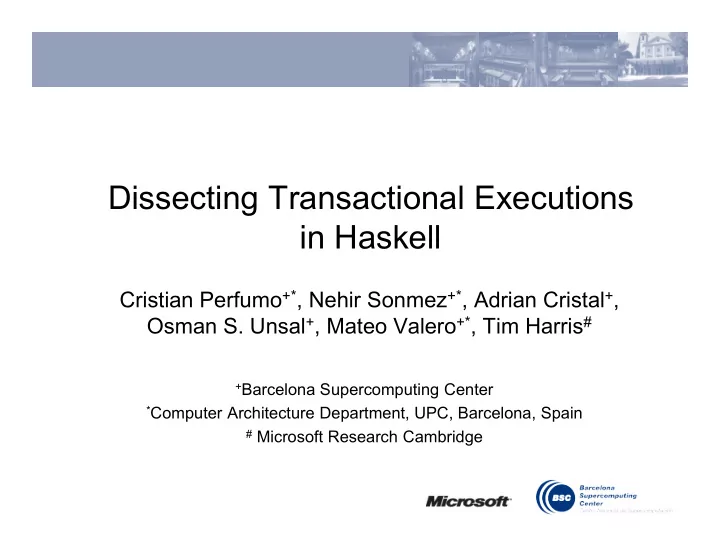

Dissecting Transactional Executions in Haskell Cristian Perfumo +* , Nehir Sonmez +* , Adrian Cristal + , Osman S. Unsal + , Mateo Valero +* , Tim Harris # + Barcelona Supercomputing Center * Computer Architecture Department, UPC, Barcelona, Spain # Microsoft Research Cambridge 1
Motivation • Haskell is a great tool to try out ideas on transactional memory. • Need more detail than just execution time. – Big rollback rate? – Time in the commit phase? – Overhead of the transactional runtime? – Relationship between number of reads and readset? Writes? Transactional read-to-write ratio? – Trend with more processors? • Dearth of transactional benchmarks for Haskell. 2
Contributions • A Haskell STM application suite that can be used as a benchmark by the research community. • Addition of detailed transactional data gathering module in Haskell STM. • Based on the collected raw data, new metrics are derived. • These metrics can be used to characterize STM applications. 3
Background in Haskell STM • Pure and lazy functional programming language. • Write-buffer and lazy conflict detection. • Object-based conflict detection. • The IO world and the STM world are separated thanks to monads. – Tvars can’t be accessed non-transactionally 4
Applications in the suite • Some are developed by us and some by developers that don’t know about the internals of the (underlying) STM implementation . • Different lengths. • Different number of atomic blocks. 5
Gathered statistics • For committed and aborted transactions: – Number of transactions. – Work time. – Commit phase time. – Number of transactional reads and writes. – Readset and writeset lengths (in objects). • Histogram of rollbacks 6
Execution time • 8 cores (four dual-core SMP) Intel Xeon 5000 3.0 GHz processors. • 4MB L2 cache/processor. • 16GB of total memory. • Exactly as many threads as physical cores. • All of the reported results are based on the average of five executions. 7
Execution time (cont.) • Normalized to one-core configuration execution times. • They allow us to see scalability. 8
Inside and outside a transaction • The more the time inside a transaction, the more the gain in performance by optimizing STM runtime. (Amdahl’s Law) 100% % out a Tx 90% 80% % in a Tx 70% 60% 50% 40% 30% 20% 10% 0% 1 2 4 8 1 2 4 8 1 2 4 8 1 2 4 8 1 2 4 8 1 2 4 8 1 2 4 8 1 2 4 8 1 2 4 8 1 2 4 8 1 2 4 8 1 2 4 8 1 2 4 8 Blockw orld Gcd LL10 LL100 LL1000 LLUnr10 LLUnr100 LLUnr1000 Prime SingleInt Sudoku Tcache Unionfind 9
Stats: Rollback rate • Allows classifying applications in different groups. • Accordingly to the group they belong to, the STM runtime can implement different optimizations. 10
Stats: Rollback histograms • Observation: a transaction can be rolled back several (10+) times. • Therefore: STM can incorporate mechanisms to ensure fairness 11
Stats: Wasted work • Wasted work: ( ) T aborted ( ) ( ) T aborted T committed + 100,00% % Useful 90,00% % Wasted 80,00% 70,00% 60,00% 50,00% 40,00% 30,00% 20,00% 10,00% 0,00% 1 2 4 8 1 2 4 8 1 2 4 8 1 2 4 8 1 2 4 8 1 2 4 8 1 2 4 8 1 2 4 8 1 2 4 8 1 2 4 8 1 2 4 8 1 2 4 8 1 2 4 8 Blockworld Gcd LL10 LL100 LL1000 LLUnr10 LLUnr100 LLUnr1000 Prime SingleInt Sudoku TCache Unionfind 12
Stats: Readset size and aborts • Some apps have transactions with various readset sizes. • The bigger the readset, the bigger the probability of rollbacks (Intuition confirmed!) 8 cores ( ) AVG _ readset aborted ( ) AVG _ readset committed 13
Conclusions • Applications’ internal behavior was analyzed • When atomic is used for “non-parallelizable” problems, high rollback rates and “late commits” appear. • Foresight: A smart (dynamic) runtime system could avoid some of the problems that appeared. • Future work: expand the application set and run it with more cores (128). 14
Thank you! Questions? Now or later to cristian.perfumo@bsc.es 15
Stats: Commit phase overhead • Commit Overhead 16
Recommend
More recommend